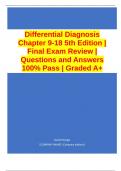Differential Diagnosis
Chapter 9-18 5th Edition |
Final Exam Review |
Questions and Answers
100% Pass | Graded A+
David Mungai
[COMPANY NAME] [Company address]
,Differential Diagnosis Chapter 9-18 5th
Edition | Final Exam Review | Questions
and Answers 100% Pass | Graded A+
Chapter 09: Screening for Hepatic and Biliary Disease -
Answer>> Answers to Practice Questions
1. Referred pain patterns associated with hepatic and biliary
pathologic conditions produce musculoskeletal symptoms in the:
a. Left shoulder
b. Right shoulder
c. Mid-back or upper back, scapular, and right shoulder areas
d. Thorax, scapulae, right or left shoulder - Answer>> (c)
Technically, answer (b) is also correct because referred shoulder
pain may be the only presenting symptom of hepatic or biliary
disease. However, when the overall referral pattern is viewed,
answer (b) leaves out the upper back and scapulae; answer (d)
refers to the part of the body between the neck and the abdomen
and includes the primary pain pattern present in the right upper
quadrant but not the mid or upper back associated with the
referred pain pattern. Kehr's sign—left shoulder pain associated
with blood or air in the abdominal cavity—is not part of the
hepatic/biliary system.
2. What is the mechanism for referred right shoulder pain from
hepatic or biliary disease? - Answer>> Radiating pain to the
mid back, scapula, and right shoulder occurs as the result of
splanchnic fibers (a network of nerves innervating the viscera of
the abdomen) that synapse with adjacent phrenic nerve fibers—
the branch of the celiac plexus (also known as the solar plexus)
that innervates the diaphragm.
The liver is innervated by the hepatic plexus, also a part of the
celiac plexus (see Fig. 3-3). Interconnecting nerve fibers between
the phrenic nerves and the brachial plexus then refer pain to the
,right shoulder. These connections occur bilaterally, but most
biliary fibers reach the dorsal spinal cord through the right
splanchnic nerve to produce pain primarily in the right shoulder.
3. Why does someone with liver dysfunction develop numbness
and tingling that is sometimes labeled carpal tunnel syndrome? -
Answer>> Normally, the breakdown of protein in the gut
(whether derived from food or blood in the stomach) produces
ammonia that is transformed by the liver to urea, glutamine, and
asparagine. These substances are then excreted by the renal
system. When the liver is diseased and unable to detoxify
ammonia, ammonia is transported to the brain, where it reacts
with glutamate, an excitatory neurotransmitter, thus producing
glutamine. Reduction in brain glutamate impairs
neurotransmission, leading to altered nervous system metabolism
and function. Additionally, ammonia may cause the brain to
produce false neurotransmitters. The result of this ammonia
abnormality is peripheral nerve disease with numbness and
tingling of the hands and/or feet that can be misinterpreted as
carpal/tarsal tunnel syndrome. Check also for asterixis
4. When a client with bilateral carpal tunnel syndrome is being
evaluated, how do you screen for the possibility of a pathologic
condition of the liver? - Answer>> Ask about numbness and
tingling in the feet. Tarsal tunnel symptoms do not always occur
with upper extremity numbness and tingling, but when both are
present, a medical evaluation is required.
Ask the client about any associated signs and symptoms,
especially constitutional symptoms (see Systemic Signs and
Symptoms Requiring Physician Referral at the end of this
chapter). Look for liver flap, liver palms, and other skin and
nailbed changes.
Look for risk factors associated with liver impairment (e.g.,
alcohol use, hepatotoxic medications, previous history of any type
of cancer).
, If subjective and objective examinations do not reveal any red
flags, treatment may be initiated. If treatment does not result in
objective or subjective improvement, ask the client again about
the development of any new symptoms, especially constitutional
symptoms or other associated symptoms discussed here.
Failure to progress in treatment should result in physician
evaluation or reevaluation. The development of any new systemic
symptoms requires medical evaluation as well.
5. What is the first most common sign associated with liver
disease? - Answer>> Jaundice is first noted as a yellowing of
the sclera of the eyes. The skin may take on a yellow hue as well,
but this is not as easily observed as the change in the eye. This
change in eye and skin color can also occur with pernicious
anemia (A decrease in red blood cells when the body can't absorb
enough vitamin B-12.), a condition that may be accompanied by
peripheral neuropathy as well.
6. You are treating a 53-year-old woman who has had an
extensive medical history that includes bilateral kidney disease
with kidney removal on one side and transplantation on the other.
The client is 10 years posttransplant and has now developed
multiple problems as a result of the long-term use of
immunosuppressants (cyclosporine to prevent organ rejection)
and
corticosteroids (prednisone). For example, she is extremely
osteoporotic and has been diagnosed with cytomegalovirus and
corticosteroid-induced myopathy. The client has fallen and
broken her vertebra, ankle, and wrist on separate occasions. You
are seeing her at home to implement a strengthening program
and to instruct her in a falling prevention program, including home
modifications. You notice the sclerae of her eyes are yellow-
tinged. How do you tactfully ask her about this? - Answer>>
Given most people's concern about their physical appearance, it




